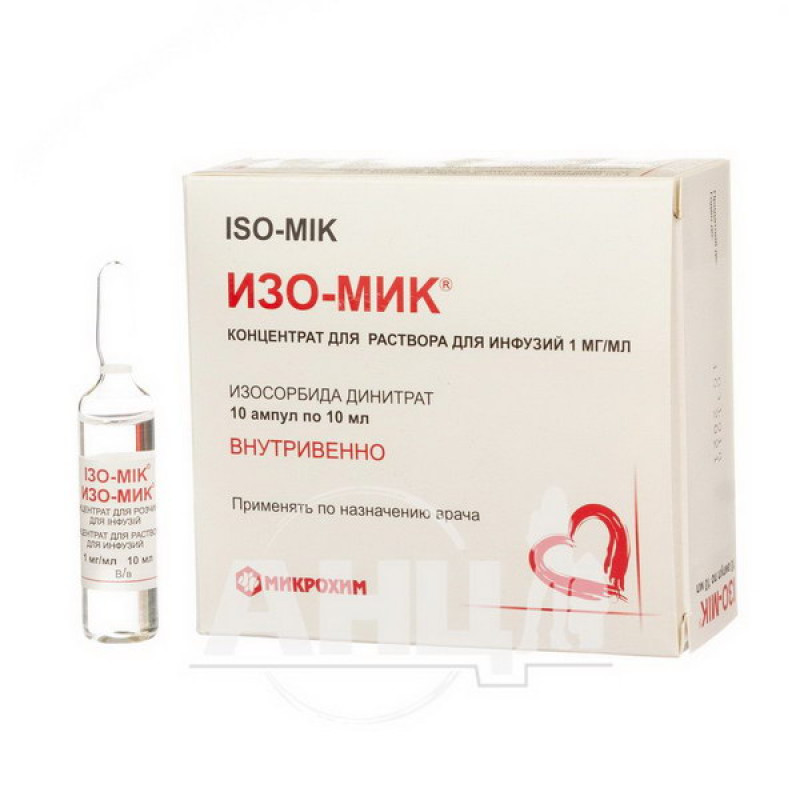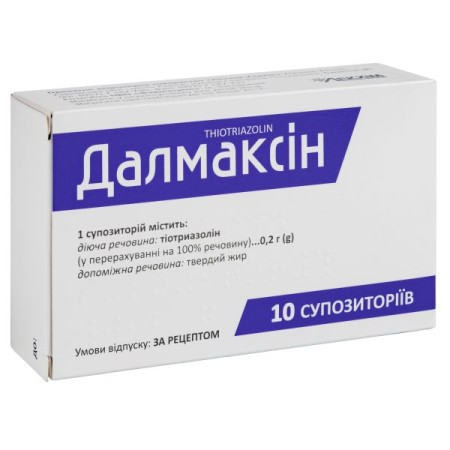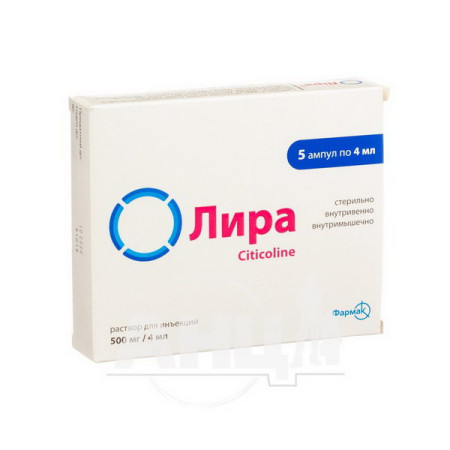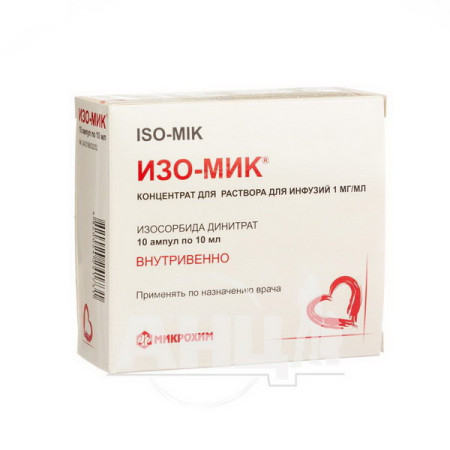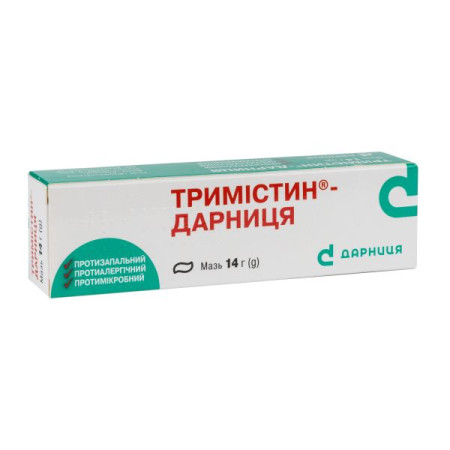Iso-mic concentrate for infusion solution 0.1% ampoule 10 ml No. 10
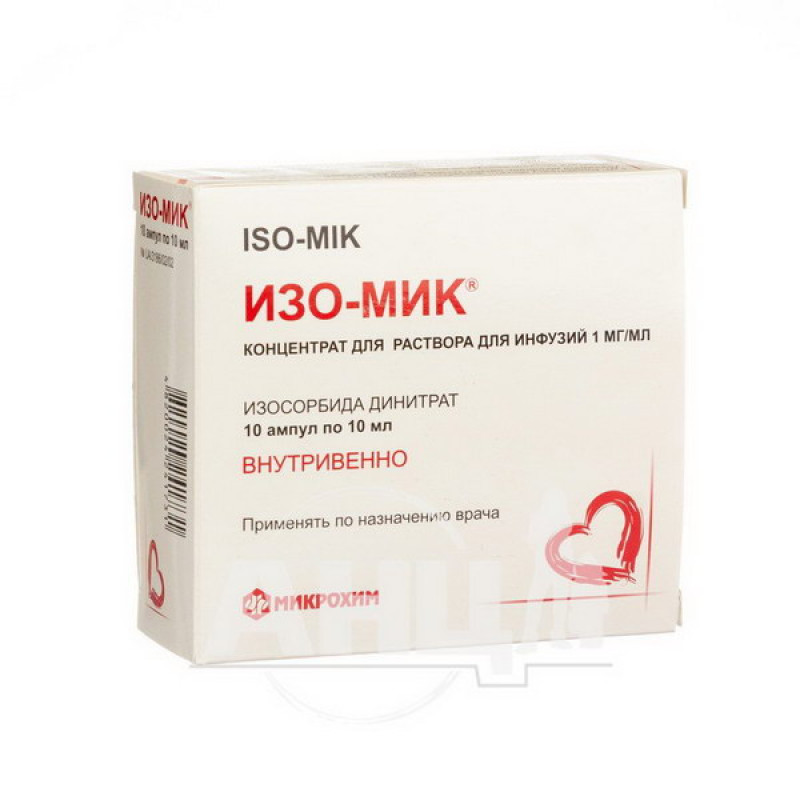
Pharmacological properties
Pharmacodynamics. Isosorbide dinitrate is an antianginal agent, a vasodilator that acts mainly on venous vessels, also relaxes the arteries. Due to this, the volume of venous return to the heart decreases; thus, the ventricular end-diastolic pressure and volume (preload) decrease. The effect on the arteries, and at higher doses on the arterioles, leads to a decrease in systemic vascular resistance (afterload). This, in turn, facilitates the work of the heart. The effect on both pre- and afterload leads to a further reduction in oxygen loss in the heart. In addition, isosorbide dinitrate causes a redistribution of blood flow towards the subendocardial parts of the heart if the coronary circulation is impaired due to atherosclerotic lesions. This effect is possibly due to the selective dilation of large coronary arteries. Dilation of collateral arteries caused by nitrates can improve perfusion of ischemic areas.
In patients with congestive heart failure, nitrates improve hemodynamics at rest and during exercise. This beneficial effect involves several mechanisms, including improvement in valvular regurgitation (due to reduced ventricular dilatation) and decreased myocardial oxygen consumption. By reducing oxygen demand and increasing oxygen delivery, the area of myocardial damage is reduced. Thus, isosorbide dinitrate may be beneficial in patients with myocardial infarction.
Effects on other organ systems include relaxation of bronchial muscles, gastrointestinal muscles, and biliary and urinary tract muscles. A relaxing effect on uterine smooth muscle has been reported.
Mechanism of action
Isosorbide dinitrate acts as a nitric oxide (NO) donor, which leads to relaxation of vascular smooth muscle by stimulating guanylyl cyclase and a subsequent increase in the concentration of cyclic guanosine monophosphate (cGMP), the latter considered a mediator of relaxation. cGMP-dependent protein kinase is thus stimulated, and as a result, a change in the phosphorylation of various proteins in smooth muscle cells occurs. This ultimately leads to dephosphorylation of the myosin light chain and a decrease in contractility.
Pharmacokinetics. T ½ of isosorbide dinitrate after i / v infusion is 20 min. Isosorbide dinitrate is metabolized in the liver to form isosorbide-2-mononitrate and isosorbide-5-mononitrate with T ½ of 1.5-2 and 4-6 hours, respectively. Both metabolites are pharmacologically active.
The drug is excreted in the urine, almost entirely in the form of metabolites. The bioavailability of the drug is 25%.
Indication
Symptomatic treatment of unstable angina in addition to standard therapy, long-term therapy of vasospastic angina (Prinzmetal's angina); acute left ventricular heart failure of various etiologies (weakness of the heart muscle with impaired left ventricular function); acute myocardial infarction.Application
The drug should be used intravenously or intracoronarily for intensive care in adults only in a hospital setting!
The dose is determined individually, taking into account the clinical picture and condition of the patient, with constant monitoring of clinical and hemodynamic parameters.
In / in drip administration. Therapy should be started with a dose of 1-2 mg / h, gradually increasing it to the required to ensure the optimal therapeutic effect. The maximum dose usually does not exceed 8-10 mg / h, but for patients with heart failure this dose can be increased to 10-50 mg / h. For patients who have previously received therapy with organic nitrate compounds, for example, isosorbide dinitrate or isosorbide-5-mononitrate, the use of higher doses of the drug may be required to achieve the desired hemodynamic effect.
Elderly patients.
There are no data on the need for dose adjustment in elderly patients.
Pediatric population.
The safety and effectiveness of isosorbide dinitrate in children have not been established.
Method of application.
Administer a 0.1% solution of the drug:
pre-diluted as a continuous infusion using automatic infusion systems; undiluted using a syringe pump, in a hospital setting with constant monitoring of cardiovascular system indicators. Depending on the disease and its severity, in addition to the usual examination (symptoms, blood pressure, heart rate, diuresis), invasive methods for determining hemodynamics should be used. Ampoules should be opened under aseptic conditions immediately before use. The diluted solution should be used immediately. Use of diluted solutionsPreparation of solutions of different concentrations:
0.1 mg/ml (0.01%): 50 ml of the drug (5 ampoules of 10 ml) should be made up to 500 ml with one of the solutions listed below.
0.2 mg/ml (0.02%) 100 ml of the drug (10 ampoules of 10 ml) should be brought to a volume of 500 ml with one of the solutions listed below.
Dilution solutions: saline solution, 5-30% glucose solution, Ringer's solution, solutions containing albumin.
Dosage of diluted solutions (1 ml of solution is equivalent to 20 drops):
| 100 mcg/ml 50 ml of the drug (5 ampoules of 10 ml) bring to a volume of 500 ml of solution | prescribed dose | 200 mcg/ml 100 ml of the drug (10 ampoules of 10 ml) bring to a volume of 500 ml of solution | ||
| infusion rate | infusion rate | |||
| ml/h | drops / min | mg/h | ml/h | drops / min | 10 | 3-4 | 1 | 5 | 1-2 |
| 20 | 7 | 2 | 10 | 3 |
| 30 | 10 | 3 | 15 | 5 |
| 40 | 13 | 4 | 20 | 7 |
| 50 | 17 | 5 | 25 | 8 |
| 60 | 20 | 6 | 30 | 10 |
| 70 | 23 | 7 | 35 | 12 |
| 80 | 27 | 8 | 40 | 13 |
| 90 | 30 | 9 | 45 | 15 |
| 100 | 33 | 10 | 50 | 17 |
Use of undiluted solutions
The drug can be administered undiluted using a perfusor. 1 ml of the drug contains 1 mg of isosorbide dinitrate.
When entering, it is necessary
There are no reviews for this product.
There are no reviews for this product, be the first to leave your review.
No questions about this product, be the first and ask your question.






